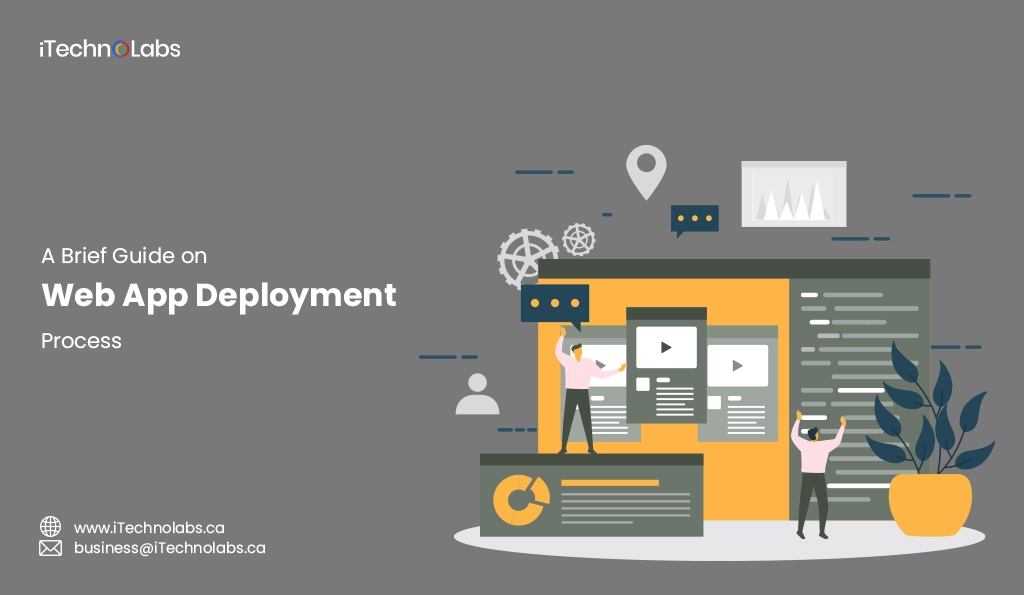Web app deployment stands as a pivotal and indispensable phase in the lifecycle of any web application development. It encapsulates the comprehensive process of making the application readily available to end-users by proficiently hosting it on either a dedicated server or a versatile cloud platform. However, this phase transcends merely bringing the app to life; it demands thorough planning, exhaustive testing, and meticulous execution to guarantee that the web app functions seamlessly and provides an exceptional user experience to its target audience.
In this detailed guide, we will embark on an in-depth exploration of the multifaceted stages involved in the web app deployment process. Our journey will commence with the critical decision of selecting the most suitable hosting environment, considering factors such as scalability, cost, and security. Following this, we will navigate through the preparation of the application for deployment, which includes optimizing the code, ensuring database integrity, and implementing necessary security measures to protect against potential threats.
As we progress, we will delve into the intricacies of deploying the application, detailing the steps to upload the web app to the hosting environment, configure the server settings, and establish the necessary connections between the app and any external services or APIs it may rely on. This phase also encompasses rigorous testing to identify and rectify any issues that could impede performance or user experience.
Post-deployment, our focus will shift to monitoring the application’s performance and user interaction. This involves analyzing usage patterns, identifying bottlenecks, and gathering feedback to inform future improvements. Continuous monitoring is essential for promptly addressing any operational issues and ensuring the application remains aligned with user expectations and technological advancements.
Furthermore, this guide will offer valuable insights and tips for achieving a successful deployment. This includes adopting best practices for ensuring robust security measures to protect sensitive data, enhancing scalability to accommodate user growth, and implementing continuous integration and deployment strategies to streamline updates and maintain the app’s relevance.
What is Deployment in Web Application?
Deployment in web application development is the critical final step that involves making the web application accessible to end-users. This process encompasses several key stages, including the preparation of the application for release, uploading the necessary files to a server or hosting environment, configuring the server settings to ensure the application runs smoothly, and managing any updates or maintenance tasks. Deployment is not just about transferring files; it’s about ensuring that the application is optimized for performance, security, and reliability in a live environment. This phase is a pivotal part of the software development life cycle, determining the application’s success by affecting its usability, accessibility, and overall user experience. Without proper deployment practices, even the most well-designed web applications can fail to meet their potential in real-world usage.
Also Read: Brief Guide on Custom Web Application Development
5 Step-by-Step Process of Web App Deployment
Step 1. Prepare the Code for Deployment
Before deploying a web application, it’s essential to ensure that the code is clean, secure, and well-documented. This includes debugging any errors or issues to prevent potential problems in the live environment. Additionally, optimizing the code for performance and scalability can significantly impact the user experience and long-term success of the application.
Step 2. Configure the Code for Deployment on the Web Server
After preparing the code, it becomes essential to configure it for deployment on a web server. This process starts with creating a virtual environment, which isolates your project’s Python environment and its dependencies from other projects, ensuring compatibility and preventing conflicts. Next, setting up the database is a pivotal step, involving defining schemas, tables, and relationships that will efficiently store and manage your application’s data. Server-side configurations are also necessary, adjusting settings to optimize performance, security, and resource management based on the web server’s specifications. Additionally, installing any necessary libraries or dependencies is crucial for supporting your application’s functionality; this might include frameworks, utility libraries, or API clients. Before proceeding, it’s crucial to test the configuration thoroughly.
Step 3. Transfer the Web Application to the Production Environment
Once you have finished coding and configuring the server settings, the next step is to migrate the web application to the production environment. This critical phase often relies on a version control system, such as Git or SVN. You would use these tools to either clone your project directly or pull the latest changes onto the live server, ensuring that the most current version of your application is deployed. After successfully transferring the files, comprehensive testing is imperative to identify and rectify any issues that might affect the user experience or functionality of the application. Only after thorough testing and verification should the application be made publicly accessible, guaranteeing a smooth and reliable user experience.
Step 4. Launch the Web Application to the Server
The final step is launching the web application, and making it available to users on the server. This involves configuring the necessary network settings and ensuring that all domain names are correctly pointing to your server’s IP address. Additionally, setting up a monitoring system is crucial to ensure that the application remains stable and functional for its users. It is also essential to regularly update and maintain the web application, ensuring it remains secure and meets the latest technology standards. Once these steps are complete, your web application should be successfully deployed and ready for public use. However, as with any development process, continuous monitoring and updates are necessary to keep the application running smoothly and efficiently. Thus, it is crucial to have a reliable maintenance plan in place to ensure constant improvement and enhancement of the web application. With proper management, your web application can continue to grow and evolve, providing a valuable service to its users.
Step 5. Maintenance and Monitoring of the Web Application
Maintenance and monitoring of the web application are essential to ensure its continuous functionality and user satisfaction. Regular updates, bug fixes, security checks, and performance optimizations are all part of maintaining a successful web application. It is crucial to have a dedicated team or individual responsible for these tasks to guarantee that the application remains stable and up-to-date. Additionally, implementing a monitoring system allows for early detection of any issues or potential problems, preventing downtime and user dissatisfaction.
Web Application Deployment Methods and Tools
There are various methods and tools available for deploying a web application. Some of the popular ones include:
| Deployment Method | Tools | Description |
| Continuous Integration/Continuous Deployment (CI/CD) | Jenkins, GitLab CI, CircleCI | Automates the deployment process by building, testing, and deploying web applications upon every code change, ensuring rapid delivery and high-quality software. |
| Containerization | Docker, Kubernetes | Utilizes containers to package the application with all its dependencies, ensuring consistency across different environments and simplifying deployment. |
| Cloud Providers | AWS (Amazon Web Services), Google Cloud, Microsoft Azure | Offers a range of services for deploying and managing web applications, providing scalability, reliability, and global reach. |
| Manual Deployment | FTP, SCP | Involves manually transferring files to the hosting environment. While simple, it lacks the automation and scalability of other methods. |
10 Best Practices for Web App Deployment
Use Version Control Systems
One of the best practices for deploying web applications efficiently involves utilizing a version control system (VCS), like Git. By adopting VCS, developers gain the ability to meticulously track every alteration made to the codebase, providing a detailed history of changes. This becomes particularly useful when issues arise, as it allows for a swift reversion to earlier, stable versions of the software, ensuring minimal downtime. Additionally, VCS facilitates smoother collaboration among team members, regardless of their physical location. It simplifies the process of merging code changes from multiple sources, ensuring that updates are managed seamlessly and efficiently. This collaborative aspect of VCS is invaluable in today’s development environment, where team members often work on different components simultaneously, making it easier to synchronize and manage code updates across the board.
Employ Automated Testing
Deploying unstable code can lead to a variety of issues, ranging from minor bugs to severe crashes. To avoid this, developers should incorporate automated testing into their deployment process. This involves creating and running test suites that exercise different aspects of the web application, ensuring that everything works as expected before launching it to the public. Automated testing provides a safety net for developers, catching any errors or issues that may have gone unnoticed during the development stage. By identifying and fixing these problems early on, developers can save time and resources in the long run, preventing disruptions to the end-user experience.
Implement Continuous Integration/Continuous Deployment (CI/CD)
CI/CD is a DevOps practice that involves automating the integration and deployment of code changes. It ensures that any updates made by developers are regularly and consistently merged into the main codebase, reducing the risk of conflicts or delays. This approach also enables teams to deploy new features or bug fixes quickly and continuously, without disrupting existing functions. By streamlining the development process, CI/CD helps teams to deliver high-quality code faster and with greater efficiency.
Leverage Configuration Management
Configuration management is the process of tracking and controlling changes to software and infrastructure settings. It involves using tools and techniques to manage and automate these configurations, ensuring consistency across development, testing, staging, and production environments. With configuration management in place, developers can easily set up new servers or replicate existing ones without having to manually configure each one individually. This not only saves time but also minimizes the risk of human error, leading to a more reliable and stable codebase.
Optimize for the Production Environment
Developers should always consider the production environment when writing and testing code. This includes factors such as server load, scalability, security, and performance. By optimizing for the production environment from the beginning, developers can catch any potential issues early on and make necessary adjustments before deployment. This not only improves the quality of the code but also reduces the chances of unexpected problems arising in a live environment.
Use Blue/Green or Canary Deployments
Blue/Green and Canary deployments are two popular strategies for releasing code into production. In Blue/Green deployments, two identical environments (blue and green) are set up, with only one active at a time. New releases are deployed to the inactive environment, allowing developers to test the changes before switching over to the new version. This minimizes downtime and allows for quick rollbacks if any issues arise.
Canary deployments, on the other hand, involve gradually rolling out new code to a small percentage of users while monitoring its performance. If everything goes well, the rollout is expanded to more users until it reaches 100%. This approach allows for gradual and safe deployments, minimizing the impact of any potential issues.
Monitor Your Application
To guarantee a smooth and stable production environment, it is essential to vigilantly monitor your application’s performance and swiftly identify any potential issues that may arise. This critical task involves tracking various metrics such as server load, response times, error rates, and other key performance indicators. By implementing comprehensive monitoring strategies, developers can gain valuable insights into the health of the application. This enables them to proactively address minor problems before they develop into more significant issues, potentially averting downtime and ensuring a seamless user experience. Additionally, continuous monitoring can highlight opportunities for optimization, further enhancing the application’s efficiency and reliability.
Implement Security Measures
In today’s digital age, where technology evolves at an unprecedented pace and the threat landscape continually shifts, prioritizing security in any application is more important than ever. Given this dynamic environment, it is absolutely crucial for developers to embed robust security measures at every stage of the development process. This includes conducting thorough code reviews to catch potential vulnerabilities early on, adhering to secure coding practices to minimize risks from the outset, and performing regular vulnerability scans to identify and address security weaknesses.
Moreover, the importance of keeping software dependencies up to date cannot be overstated. Regular updates and patches are essential to protect against known vulnerabilities as they are discovered. Additionally, staying abreast of industry best practices and incorporating them into security strategies is vital for securing sensitive data against emerging threats. By taking a comprehensive and proactive approach to security, organizations can significantly bolster their defense against cyber threats and ensure the integrity, confidentiality, and availability of their applications.
Plan for Scalability
It’s common for applications to experience a surge in usage as they grow in popularity. However, if an application is not designed with scalability in mind, it can quickly become overwhelmed and crash under the weight of increased traffic. That’s why it’s essential to anticipate future growth and plan for scalability from the start.
Developers should carefully consider factors such as server capacity, load balancing, and database management when designing an application. They should also regularly monitor and test the scalability of their system to ensure it can handle increased demand. Implementing a scalable architecture not only helps maintain stable performance but also allows for easier expansion as the application grows.
Have a Rollback Strategy
Even with the most robust security measures in place, data breaches and cyber attacks can still occur. That’s why it’s crucial to have a rollback strategy in place in case of a successful attack or system failure.
A rollback strategy involves having backups and contingency plans ready to restore critical systems and data in the event of an incident. It also includes documentation on steps to take to minimize damage and mitigate the attack’s impact. Having a well-defined rollback strategy can help organizations quickly recover from an attack and prevent prolonged downtime.
Read More: A Comprehensive Guide: Custom Web Application Development 2024
10 Essential Steps to Follow Post-application Deployment
- Conduct thorough testing: Before deploying an application, developers should thoroughly test it to ensure it functions as intended and identify potential vulnerabilities that could compromise security.
- Implement security measures: Security should be a top priority when developing an application. Developers must implement robust authentication, encryption, and access control mechanisms to protect the user’s data.
- Monitor for anomalies: After deployment, developers should continuously monitor the application for any unusual activity or anomalies that could indicate a security breach.
- Have a response plan: In case of an attack or system failure, it’s crucial to have a well-defined response plan in place. This plan should include steps to contain the incident and restore affected systems.
- Regularly update software: Developers must regularly release updates and patches to fix any security vulnerabilities that may be discovered. Users should also be encouraged to update their software regularly.
- Conduct regular risk assessments: Organizations should conduct regular risk assessments to identify potential threats and implement measures to mitigate them.
- Train employees on security protocols: Employees are often the weakest link in an organization’s security. Training them on best practices for data security and how to spot potential threats can significantly reduce the risk of a successful attack.
- Backup data regularly: It’s important to regularly backup all critical data in case of a system failure or cyberattack. This will facilitate quick recovery and minimize downtime.
- Implement access controls: Only authorized personnel should have access to sensitive data and systems. Access controls, such as multi-factor authentication, should be implemented to prevent unauthorized access.
- Stay informed on emerging threats: Cybersecurity is an ever-evolving field, and new threats are constantly emerging. Developers and organizations must stay informed of the latest security trends and adapt their strategies accordingly.
How much does it cost to build a Web App?
The cost of building a web app can vary widely based on factors such as complexity, features, technology used, and the expertise of the development team. For simple web apps, development costs might range from $5,000 to $20,000. Mid-level web apps with more sophisticated functionalities could cost anywhere between $20,000 and $50,000. Complex web apps, especially those that require advanced features like integration with external services, real-time functionalities, or custom security measures, can exceed $50,000, with some projects venturing into the $100,000+ territory. It’s essential to consider that ongoing maintenance, updates, and potentially scaling costs add to the initial development expenditure over time.
- Simple Web Apps: Generally, development costs range from $5,000 to $20,000. These applications typically feature basic functionality and minimal custom design elements, making them ideal for small businesses or personal projects that require a straightforward online presence without the need for complex functionalities.
- Mid-Level Web Apps: Development costs for these applications can run between $20,000 and $50,000. They often include more intricate features and integrations compared to simple web apps. This category suits businesses looking to offer more comprehensive services online, necessitating features like user authentication, database integration, and API connections that allow for a moderate level of user interaction and data processing.
- Complex Web Apps: For applications requiring advanced features, such as real-time capabilities, custom security protocols, and extensive integration with external services, costs can exceed $50,000, sometimes reaching $100,000 or more. These are often enterprise-level applications that serve critical business functions, including extensive custom development to ensure high performance, scalability to accommodate a growing number of users, and top-notch security measures to protect sensitive data.
- Maintenance and Updates: It’s crucial to budget for ongoing costs beyond the initial development. These expenses can include server costs, updates to keep the application current with the latest technology trends, security measures to protect against new vulnerabilities, and scaling the app to support a growing user base. Regular updates and maintenance ensure the application remains efficient, secure, and able to meet the users’ needs over time, which is vital for the longevity and success of the project.
Suggested: How Much Does it Cost to Create An App
How can iTechnolabs help you to build Web Apps?
At iTechnolabs, we pride ourselves on having a highly skilled team of experienced web app developers and designers who specialize in crafting high-quality web applications tailored to your specific needs. Our comprehensive development process is meticulously designed to cover all phases of creation, from thorough planning and extensive research to innovative design and rigorous testing. This ensures that the final product not only meets but exceeds all your requirements.
We place immense importance on working closely with our clients to fully understand their business needs, objectives, and goals for the application. By doing so, we can tailor our development approach to align with your vision, ensuring a final product that truly reflects your business identity and aspirations. Our team employs the latest technologies and adheres to the best practices in the industry to develop a user-friendly, efficient, and secure web application. We are committed to creating applications that can handle high volumes of traffic and incorporate complex functionalities without compromising on performance or security.
- Customized Development: Tailor web applications to meet specific business needs and objectives, ensuring the final product not only aligns with your vision but also stands out in the digital marketplace. Utilize a bespoke approach to design and functionality that sets your application apart from competitors.
- Experienced Team: Leverage the expertise of skilled developers and designers who are adept in the latest web technologies and best practices. Our team brings years of experience to the table, ensuring your project is handled with professionalism and cutting-edge knowledge.
- Comprehensive Process: Benefit from a robust development process that includes meticulous planning, in-depth research, creative design, and rigorous testing to exceed requirements. This holistic approach ensures that every aspect of the web application is polished and optimized for success.
- User-Friendly Design: Focus on creating applications that offer an intuitive user experience, enhancing engagement and satisfaction. By prioritizing the needs and preferences of the end-user, we craft interfaces that are not only visually appealing but also easy to navigate, ensuring a seamless user journey.
- High-Performance: Develop web applications capable of handling high traffic volumes and complex functionalities without compromising speed or security. Our development methodologies are geared towards creating efficient, robust applications that perform excellently under any conditions.
- Ongoing Support: Provide continuous maintenance and updates to keep the application efficient, secure, and in line with evolving user needs. Our commitment to your project extends beyond launch, offering ongoing support to ensure your application remains relevant and high-functioning.
- Security Measures: Implement leading security protocols to protect your web application from vulnerabilities and ensure data integrity. We place a strong emphasis on security, incorporating advanced measures to safeguard your application against threats and breaches.
Are you planning to build custom web applications?
Choosing iTechnolabs for your web application development projects offers several compelling advantages. With our expert team utilizing the latest technologies, we ensure your project is not only current but also forward-thinking, aligning with both present and future trends. Our comprehensive process guarantees that every detail of your web app, from inception to launch, is crafted with precision and excellence. The user-friendly design prioritizes your audience’s engagement, creating an intuitive experience that fosters loyalty and satisfaction. Furthermore, our commitment to high performance and security means your web app will operate smoothly under any conditions, safeguarding your users’ data. Lastly, iTechnolabs’ ongoing support ensures your web application remains effective, secure, and updated, allowing you to focus on growing your business with peace of mind.
- Expertise in Latest Technologies: iTechnolabs employs cutting-edge technologies to develop web applications that are not only efficient but also scalable, ensuring your web app remains relevant in the rapidly evolving digital landscape.
- Customized Solutions: Tailored specifically to meet your business needs, iTechnolabs offers personalized web application development that perfectly aligns with your strategic objectives, enhancing your operational efficiency and market reach.
- Enhanced Performance and Reliability: With a focus on high-performance architecture, iTechnolabs ensures your web application delivers fast, reliable user experiences, crucial for maintaining user satisfaction and engagement.
- Robust Security Framework: Security is paramount at iTechnolabs. Implementing stringent security measures protects your web application from cyber threats and vulnerabilities, ensuring the safety and integrity of user data.
- Responsive Design: Understanding the importance of mobile audiences, iTechnolabs develops web applications with responsive design, guaranteeing an optimal viewing experience across all devices, from desktops to smartphones.
- Ongoing Support and Maintenance: The relationship doesn’t end at launch. iTechnolabs offers continuous support and maintenance, keeping your web application updated with the latest features and security measures, ensuring longevity and sustained performance.
- Cost-Effectiveness: By optimizing development processes and leveraging efficient project management techniques, iTechnolabs provides cost-effective web application development services, delivering high value for your investment.
Important: Best Framework for Server-Side Application Development
Conclusion:
In today’s fast-paced business world, having a competitive and efficient web application is crucial for success. iTechnolabs offers comprehensive web application development services that are tailored to meet the unique needs of your business. With a focus on performance, security, responsive design, ongoing support and maintenance, and cost-effectiveness, iTechnolabs ensures that your web application not only meets but exceeds your expectations. Trust in iTechnolabs for all your web application development needs and take your business to the next level.
Frequently Asked Questions About Web App Deployment
How does web application deployment affect the performance of a web app?
Web application deployment is a critical factor that significantly influences the performance and reliability of a web application. This crucial process encompasses the steps required to make a web application readily available for use by end-users across the internet. By meticulously executing a deployment, developers ensure that their web app is not only accessible to its intended audience but also maintains stability and security against potential threats. Furthermore, a well-planned deployment strategy enhances the overall user experience by prioritizing fast loading times and seamless functionality, thereby reducing the likelihood of user frustration and ensuring that the application meets the high expectations of today’s tech-savvy users. Additionally, effective deployment practices can facilitate easier updates and maintenance down the line, ensuring that the application can evolve in response to user feedback and emerging technologies.
Why is choosing the right deployment method important for a web application?
Choosing the right deployment method is essential for a web application as it can have a significant impact on its functionality, security, and maintenance. Different types of web applications may require unique deployment methods depending on their purpose, complexity, and scalability. For instance, a simple static website may only require a basic deployment strategy using a file transfer protocol (FTP) to upload files to a web server, while a more complex and dynamic web application may need a different approach. Additionally, the deployment method chosen can affect the performance of the web application, with some methods offering faster loading times and better scalability than others. Therefore, it is crucial to carefully consider the needs of the specific web application and choose a deployment method that caters to those needs effectively.








